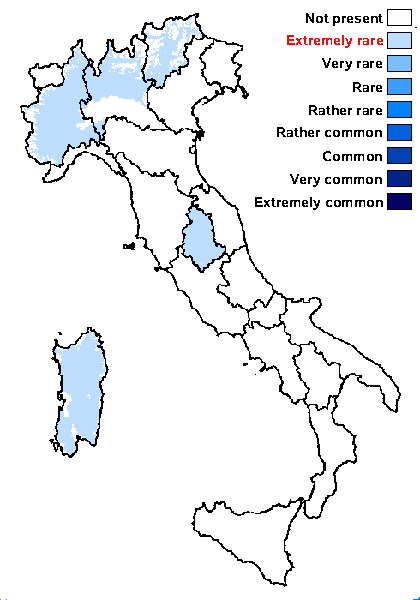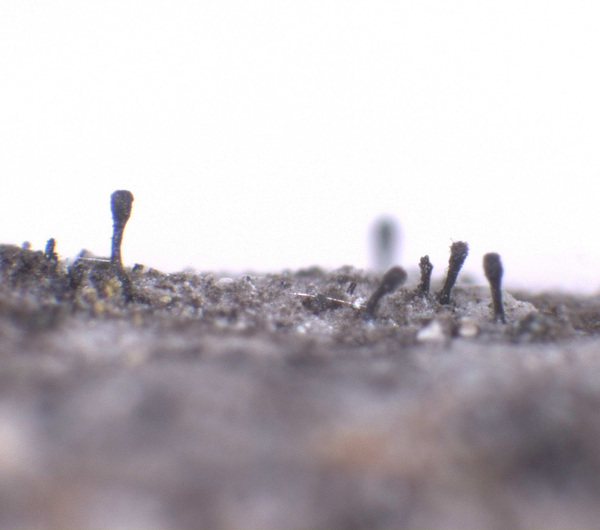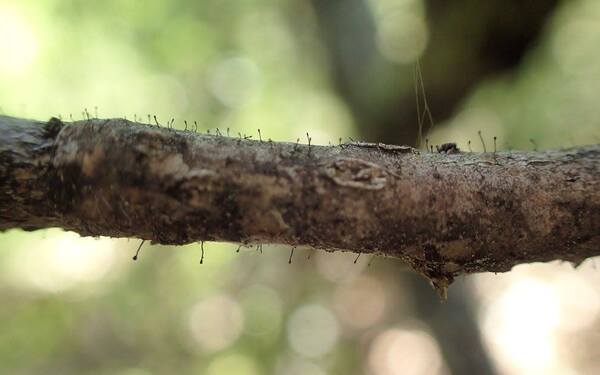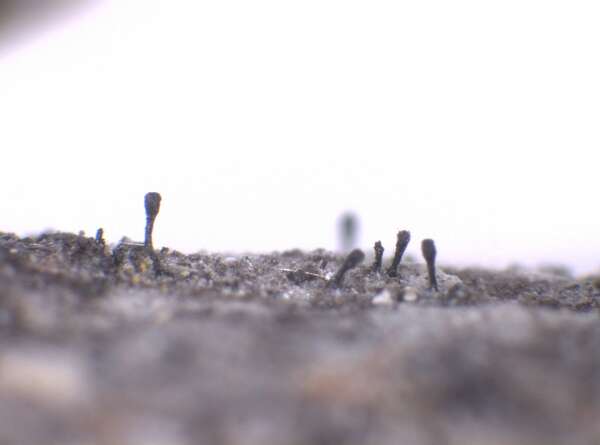Phaeocalicium populneum (Duby) A.F.W. Schmidt
Mitt. Staatsinst. allg. Bot. Hamburg, 13: 132, 1970. Basionym: Calicium populneum Brond. ex Duby - Bot. Gall., 2: 638, 1830.
Synonyms: Calicium exile Anzi?; Embolidium populneum (Duby) Vain.; Phacotium populneum (Duby) Trevis.
Distribution: N - TAA (Nascimbene & al. 2007b, Puntillo & Puntillo 2009), Lomb (Puntillo & Puntillo 2009), Piem (Puntillo & Puntillo 2009). C - Umb (CLU 12212), Sar (Puntillo & Puntillo 2009).
Description: Thallus not evident, not lichenized. Apothecia stalked, dark grey to black, glossy, 0.4-0.7 mm high, the stalk to 0.04-0.06 mm thick, reddish in section, at least in the outer part, consisting of thick-walled, periclinally arranged hyphae filled with a reddish, oily substance, surrounded by a 2-5 µm thick, colourless gelatinous coat. Capitulum lenticular, 0.2-0.3 mm across, black, epruinose; mazaedium absent. Exciple well-developed, brown to reddish brown, with an aeruginose tinge in the inner part, 6-19 µm thick, formed by 3-6 layers of periclinallly arranged, sclerotized hyphae; epithecium brown to reddish brown, 5-12 µm thick, consisting of layers of anticlinallly arranged, sclerotized hyphae. Asci 8-spored, narrowly cylindrical, with a strongly thickened apex, formed singly from hooked ascogenous hyphae, with uniseriately arranged ascospores, persisting until the ascospores are mature. Ascospores 1-septate, medium brown, ellipsoid, 11-15(-17) x 4-6.5 µm, with a smooth to indistinctly papillate wall, the septum paler than the wall, best visible in oil immersion. Photobiont absent. Spot tests: exciple and hypothecium N+ intensified reddish; stalk (in squash preparation) K- or usually K+ intensely green, N+ intensified reddish brown. Chemistry: without lichen substances.Note: saprophytic on thin, mostly decaying twigs of Populus tremula. See also Zimmermann (2011).
Growth form: Fungus
Substrata: bark
Reproductive strategy: mainly sexual
Pioneer species
Commonnes-rarity: (info)
Alpine belt: absent
Subalpine belt: absent
Oromediterranean belt: absent
Montane belt: extremely rare
Submediterranean belt: extremely rare
Padanian area: absent
Humid submediterranean belt: extremely rare
Humid mediterranean belt: absent
Dry mediterranean belt: absent

Predictive model
Herbarium samples
Growth form: Fungus
Substrata: bark
Reproductive strategy: mainly sexual
Pioneer species
Commonnes-rarity: (info)
Alpine belt: absent
Subalpine belt: absent
Oromediterranean belt: absent
Montane belt: extremely rare
Submediterranean belt: extremely rare
Padanian area: absent
Humid submediterranean belt: extremely rare
Humid mediterranean belt: absent
Dry mediterranean belt: absent

Predictive model
| Herbarium samples |
 INDEX FUNGORUM
INDEX FUNGORUM
 GBIF
GBIF
 DOLICHENS
DOLICHENS








